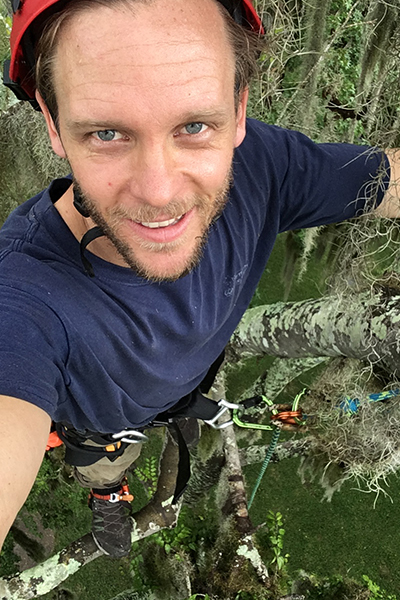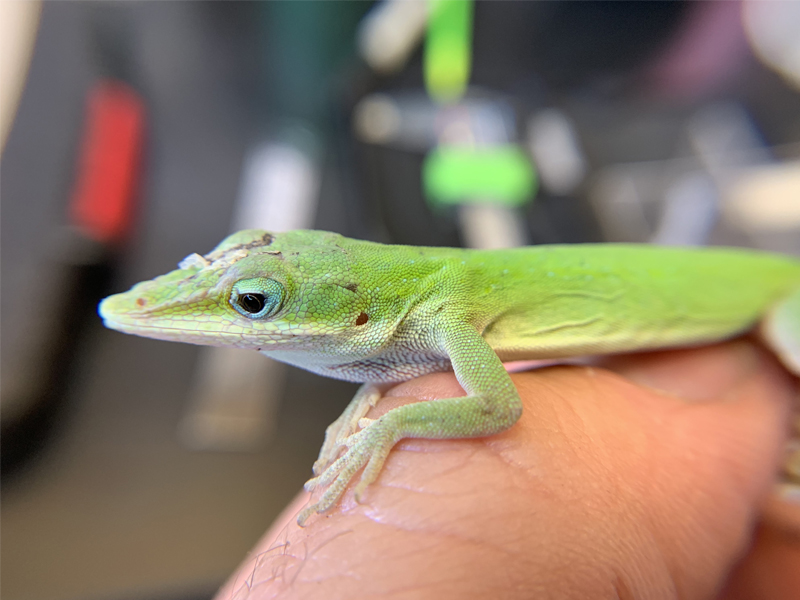- Green anole lizards used to be a common sight in much of the southeastern United States, but in places like Florida, people are now more likely to encounter the invasive brown anole, especially in urban areas.
- A UF study shows that native green anoles coexist with brown anoles by moving higher up into the tree canopy. However, green anoles are still affected by habitat loss due to urbanization.
- The study suggests that like many other animals, green anoles may benefit from access to native vegetation in home landscapes and natural areas.
The small, brightly colored lizard known as the green anole can be seen across the southeastern United States. But in places like Florida, where the invasive brown anole has also made a home, the native green anole is more elusive.
“Floridians I’ve met often remark that they used to see green anoles all the time, but not so much lately. Instead, they are seeing brown anoles,” said Jesse Borden, a Ph.D. candidate at the University of Florida in the UF/IFAS College of Agricultural and Life Sciences.
It seemed a classic case of a versatile invasive species edging out a native one.
However, a new study led by Borden suggests that green anoles have found a way to co-exist with their invasive cousin, though they still face other threats.
The researchers found that whenever brown anoles are around, green anoles, who tend to live in trees, move 17-times higher up in the canopy.
“Moving higher up in the trees allows green anoles to co-exist with brown anoles,” Borden said, “but even that doesn’t make them immune to the effects of habitat loss due to urbanization. We found that even though green anoles were moving up higher to avoid brown anoles, green anoles are declining while brown anoles are thriving,” said Borden, who led the study while completing his master’s degree in interdisciplinary ecology from the School of Natural Resources and Environment.
Borden and the study’s co-authors made this discovery by going in the same direction as green anoles — up.

“I got a lot of tree climbing experience while doing this research,” Borden said with a laugh. “Our data were the number of green and brown anoles we observed at ground level and up in trees.”
Borden and the research team conducted 121 tree climbs in both urban and natural areas in and around Gainesville, a city in north central Florida and home to the University of Florida.
If green anoles are moving higher up in trees when brown anoles are around, and brown anoles are become more common in urban areas, that may explain why people seem to see fewer green anoles across Florida nowadays.
“They could just be hanging out in the trees, out of sight,” Borden said. “We most often saw green anoles in natural areas, but as you move into areas that are more urbanized, and thus have fewer trees and habitat for green anoles, their numbers decrease. The opposite is true for brown anoles, which appear to thrive among urban structures.”
Ecologists used to look at species conservation in terms of single factors, said Brett Scheffers, senior author of the study and an assistant professor in the UF/IFAS department of wildlife ecology and conservation. But today, things have become more complex.
“Native wildlife now face a deluge of human disturbances that are all interacting and possibly compounding,” Scheffers said. “Our study shows that the native green anole not only has to counter the threat of invasive brown anoles but also the threat of urbanization, which ironically gives brown anoles the upper hand.”
However, if you miss seeing green anoles, there are steps you can take to make your landscape more welcoming, Scheffers said.

“For homeowners looking to make their property generally more attractive to wildlife, ecologists often recommend providing a variety of plants and trees of different heights. This study shows that strategy may benefit green anoles specifically,” said Scheffers, who was Borden’s master’s thesis adviser.
In addition to Borden and Scheffers, Stephanie Bohlman, an associate professor in the School of Forest, Fisheries and Geomatic sciences, co-authored the study, which is published in the journal “Oecologia.” The journal recognized the paper as a highlighted student paper for original research.
 3
3


Comments are closed.